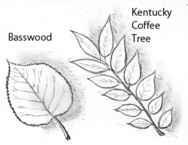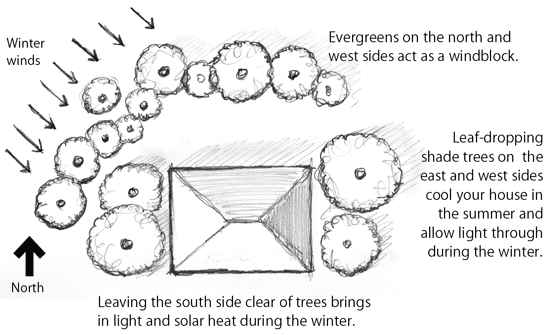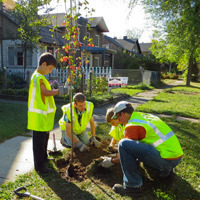 Take a look at the nearest tree. That tree is part of a
community forest--a term used to describe all the trees and shrubs in
your town. In Minnesota, trees cover about 27% of the land in our cities
and towns. However, that percentage is declining due to stress from
tree pests (such as emerald ash borer), drought, heat, and storms.
This
is where you come in. We are asking you to plant a tree this spring and care for trees
around you. You will be encouraging a healthy environment and bringing
beauty to your yard. The USDA Forest Service outlines the following
benefits of urban trees:
Save energy--and money. Energy
savings come from shading buildings, lowering ambient air temperatures,
and reducing wind speed. Trees and other vegetation can lower air
temperatures 5 °F compared with outside the tree-covered area. One
well-placed large tree provides average savings of $31 in home heating
costs each year.
Increase property values. Research comparing sales prices of residential properties suggests that people are willing to pay 3 to 7 percent more for properties with many trees versus properties with few or no trees.
Reduce storm water runoff. Leaves and
branches temporarily hold rain on their surfaces. This reduces runoff
volumes and slows soil erosion. Tree roots help rain soak into the soil
and increase total amount of rain that the soil can absorb.
Improve air quality.
Leaves intercept and hold small particles on their surfaces--like dust,
ash, pollen, and smoke—and absorb gaseous air pollution. Ground-level
ozone formation is reduced because air temperatures in tree-filled areas
are cooler.
Reduce atmospheric CO2. Trees directly
sequester CO2 in their stems and leaves while they grow. Trees near
buildings can reduce the demand for heating and air conditioning,
thereby reducing emissions associated with power production.
Healthier communities.
Tree-filled neighborhoods report lower levels of domestic violence, are
safer and more sociable, reduce stress of body and mind, decrease need
for medication, and speed recovery times.
If
you are ready to help your community forest, read on for details about
selecting a tree, planting your tree, and caring for trees.
|
What kind of tree should I plant?
Trees
come in many shapes and sizes, and each is suited for different
conditions. Think about where you will plant the tree and what your
preference is for its full-grown size and shape. Check out the DNR’s
tree planting page and the Extension’s list of species for each region
to start. Talk to your city arborist or local plant nursery staff for
recommendations.
Species suitable to many locations in Minnesota are basswood (linden), oaks, cedars, hophornbeam (ironwood), serviceberry, pines, fruit trees, hickory, kentucky coffeetree, beech, and fir. To
add diversity to our community forests, try to avoid maple and spruce,
which are already a large portion of what is planted.
Where should I plant my tree?
You
will need to consider location at the same time you select the type of
tree. Location may be determined by aesthetics, existing trees and
gardens, and power lines. Also consider these energy conservation
strategies:
 When and how should I plant the tree?
Spring and fall are best for tree planting, but you can also plant during summertime if you keep the tree well-watered. Read these directions for digging the hole, planting the tree, mulching, and watering. Remember to identify buried cables and pipes by calling Gopher State One-Call at 800-252-1166 before making your final decision or picking up a shovel.
How should I care for my trees?
Mostly, just pay attention to your trees! Use this online tool to identify the trees around you. Watch mature trees for signs of tree pests or stress. Newly planted trees need watering for 3-5 years. In drought conditions, provide mature trees with water too. If you are familiar with your trees and want more detailed tree care advice, visit the DNR's tree care page.
 Shawna MullenEardley, a Minnesota GreenCorps member in Duluth, is gaining professional experience in urban and community forestry. She is part of a team in Duluth that is actively working to increase tree cover in the city. We asked her to share some of the projects she is involved in.
How is the City of Duluth increasing tree cover in the city?
The City of Duluth has a community tree planting program called Re-Leaf Duluth, which has a couple different components. One is a street tree planting cost-share program for residents. Citizens can pay $25 for a tree, and the city not only subsidizes the cost of the tree, but we plant it for them, provide tree stakes and mulch, and educate the homeowner on how to take care of their newly planted tree. Another component is community forestry, where citizens can partake in tree planting events. We call them Planting Parties, because they really are a lot of fun. The city received a grant this fall to plant trees around city buildings (to reduce energy use) and along bike routes (to encourage non-motorized commuting). All in all, we hope to plant over 1,500 trees this year.
What is one of the projects you’ve been involved in as a GreenCorps member?
I’ve worked to inventory every tree on the boulevards of Duluth. I have also recruited and trained volunteers to help collect inventory data. The inventory will be used to assess the multiple benefits that Duluth’s urban forest provides, and attach a dollar amount to those benefits. Important planning decisions, tree planting details, and priorities will all be developed based on the results of the inventory.
What are the challenges and opportunities that Duluth faces?
One of the biggest challenges will be to plant for the future. The climate is changing…and fast. Boulevards are already a tough environment for trees to be growing in, but add the heat and dry spells that are predicted for the future, and it makes it even more challenging. At the same time, Duluth is a community that understands the value of a healthy urban tree canopy and we have a large base of citizens who love to volunteer in our tree programs. We have the potential for great growth and innovation in the area of urban forestry.
Minnesota GreenCorps is an AmeriCorps program run through the Minnesota Pollution Control Agency. Members gain valuable skills and job experience in the environmental field while giving back to the communities in which they serve. Applications are currently being invited for host sites and members for 2013-2014. Read more on our website.
|
Celebrate Arbor Day this year! April 26 kicks off an entire month of celebrations and incentives for replacing trees lost during the past years' tornadoes, floods, blowdowns, and snowstorms. Visit the DNR’s 2013 Arbor Month page to locate a celebration near you. Check out the Minnesota’s
Arbor Month Celebration, which includes seedling and tree planting, archery, a ceremony, and local Duluth leaders, May 15, 11:30
a.m.-2:30 p.m., Chester Park, (Duluth).
Mother Earth Fest is environmental and cultural celebration in St. Paul’s West Side neighborhood. You’ll find dancing, music, food, youth projects, and exhibitors, April 20, 9 a.m.-5 p.m., Paul and Sheila Wellstone Center for Community Building (West St. Paul).
Brooklyn Center EarthFest
features Allison Warden, an Inupiaq artist and rapper from Alaska,
exhibits about compost, home, garden, and energy, and kids activities,
April 20, noon-4 p.m., Brooklyn Center High School.
Do it Green! Minnesota’s Earth Day Celebration includes food samples, info tables, kids’ activities, music, and resources in Spanish, Hmong, and Somali, April 21, 12-4 p.m., Midtown Global Market (Minneapolis).
The St. Cloud Area Sustainability Expo is a marketplace for green products, organic food and produce, and a place to learn about healthy, sustainable living. Includes family activities and the presentation of the 2013 Sustainability Awards by St. Cloud Mayor Kleis and featured speaker Don Shelby, April 21, 11 a.m.-3 p.m., St. Cloud River's Edge Convention Center.
ArtStart’s EcoArts Fest
educates and inspires the next generation of stewards for our earth
through the arts, May 18, 11 a.m.-5 p.m., Harriet Island Grounds and
Pavilion (Saint Paul).
MN Goes Green is a free event at the newly renovated St. Paul Union Depot. Interactive entertainment and and educational activities will show you how to incorporate simple, practical, sustainable, and fun ideas into your everyday life, May 18, 9 a.m.-6 p.m.
Thank
you for reading Living Green 365. This newsletter is a publication of
the Minnesota Pollution Control Agency. Please send questions or
comments about living green to the address below.
Sincerely,
Britt Gangeness and the Living Green Team
livinggreen365.pca@state.mn.us
|